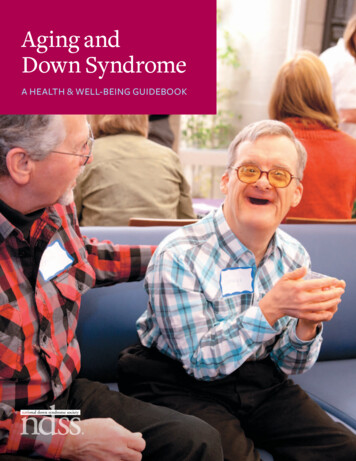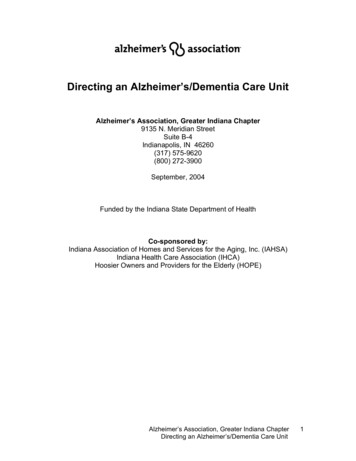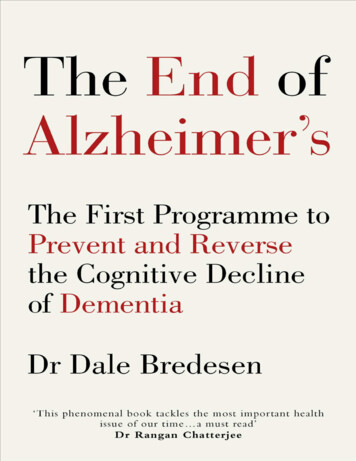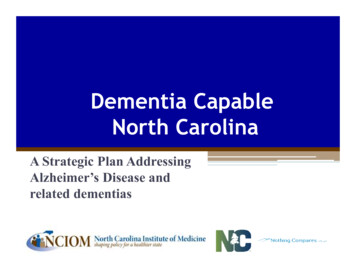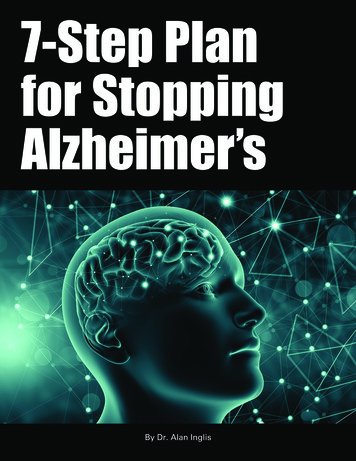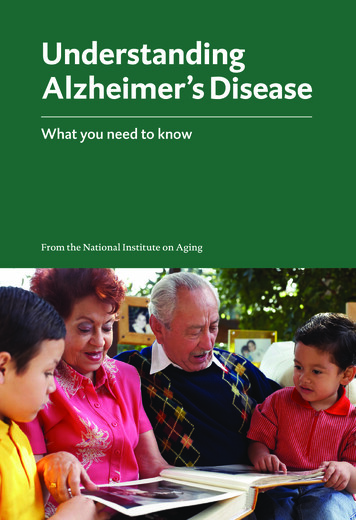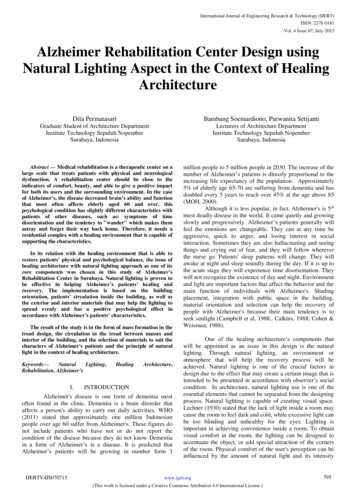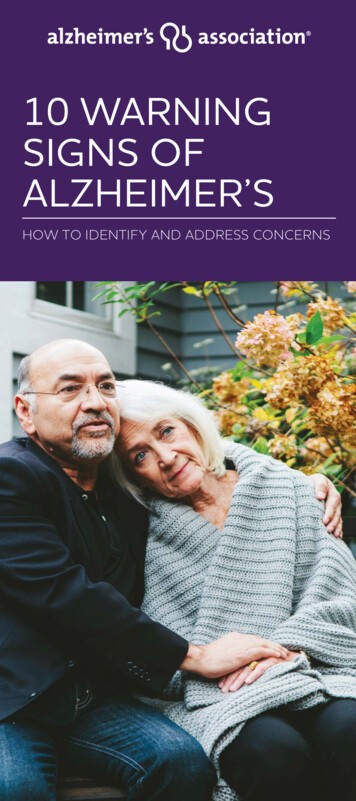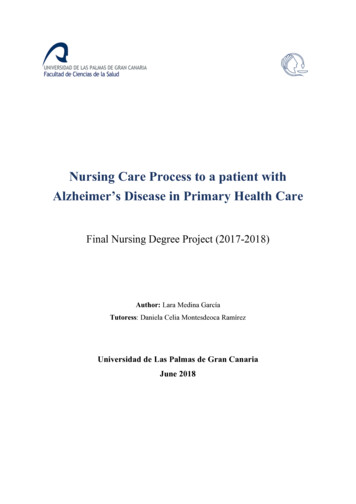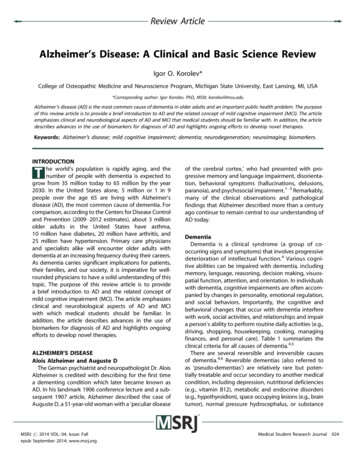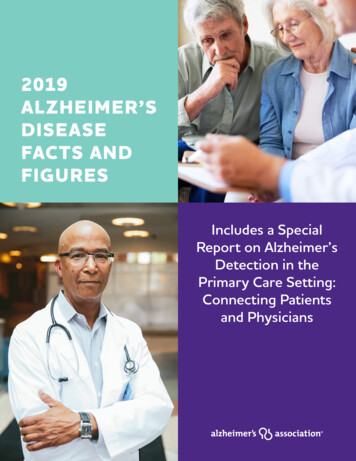
Transcription
2019ALZHEIMER’SDISEASEFACTS ANDFIGURESIncludes a SpecialReport on Alzheimer’sDetection in thePrimary Care Setting:Connecting Patientsand Physicians
About this report2019 Alzheimer’s Disease Facts and Figures is a statisticalresource for U.S. data related to Alzheimer’s disease,the most common cause of dementia. Background andcontext for interpretation of the data are contained in theoverview. Additional sections address prevalence, mortalityand morbidity, caregiving and use and costs of health care,long-term care and hospice. A Special Report discussesAlzheimer's detection in the primary care ociation.2019 Alzheimer’s2019 Alzheimer’sDiseaseDiseaseFacts andFactsFigures.and :321-87.2019;15(3):321-87.
Specific information in this year’sAlzheimer’s Disease Facts and Figures includes: Brain changes that occur with Alzheimer’s disease(page 5). Risk factors for Alzheimer’s dementia (page 12). Number of Americans with Alzheimer’s dementianationally (page 17) and for each state (page 19). Lifetime risk for developing Alzheimer’s dementia(page 19). Proportion of women and men with Alzheimer’s andother dementias (page 19). Number of deaths due to Alzheimer’s diseasenationally (page 25) and for each state (page 27), anddeath rates by age (page 28). The impact of caregiving on caregivers (page 34). Number of family caregivers, hours of care provided,and economic value of unpaid care nationally (page 31)and for each state (pages 36-37). National cost of care for individuals with Alzheimer’s orother dementias, including costs paid by Medicare andMedicaid and costs paid out of pocket (page 43). Medicare payments for people with dementiacompared with people without dementia (page 45). Attitudes toward cognitive assessment among seniorsand primary care physicians (page 64). Awareness and use of the Medicare Annual Wellness Visitamong seniors and primary care physicians (page 65).The Appendices detail sources and methods used toderive statistics in this report.When possible, specific information about Alzheimer’sis provided; in other cases, the reference may be a moregeneral one of “Alzheimer’s or other dementias.”2019 Alzheimer’s Disease Facts and Figures1
CONTE NT SOverviewBrain Changes Associated with Alzheimer’s Disease 5Stages of Alzheimer’s Disease 5Diagnosis of Dementia Due to Alzheimer’s Disease 8Treatment of Alzheimer’s Dementia 10Living with Alzheimer’s Dementia 11Uncommon Genetic Factors Associated with Alzheimer’s Disease 11Risk Factors for Alzheimer’s Dementia 12Looking to the Future 15PrevalencePrevalence of Alzheimer’s and Other Dementias in the United States 17Incidence of Alzheimer’s Dementia 18Lifetime Risk of Alzheimer’s Dementia 19Estimates of the Number of People with Alzheimer’s Dementia by State 19Differences Between Women and Men in the Prevalence and Risk of Alzheimer’s and Other Dementias 19Racial and Ethnic Differences in the Prevalence of Alzheimer’s and Other Dementias 21Trends in the Prevalence and Incidence of Alzheimer’s Dementia Over Time 23Mortality and Morbidity2Deaths from Alzheimer’s Disease 25Public Health Impact of Deaths from Alzheimer’s Disease 25State-by-State Deaths from Alzheimer’s Disease 25Alzheimer’s Disease Death Rates 26Duration of Illness from Diagnosis to Death 26Burden of Alzheimer’s Disease 28Alzheimer’s Association. 2019 Alzheimer’s Disease Facts and Figures. Alzheimers Dement 2019;15(3):321-87.
CaregivingUnpaid Caregivers 31Who Are the Caregivers? 31Caregiving and Women 31Caregiving Tasks 32Duration of Caregiving 33Hours of Unpaid Care and Economic Value of Caregiving 33Impact of Alzheimer’s Caregiving 34Interventions Designed to Assist Caregivers 39Paid Caregivers 40Direct-Care Workers for People with Alzheimer’s or Other Dementias 40Shortage of Geriatric Health Care Professionals in the United States 40Enhancing Health Care for Family Caregivers 41Trends in Dementia Caregiving 41Use and Costs of Health Care, Long-Term Care and HospiceTotal Cost of Health Care and Long-Term Care 43Use and Costs of Health Care Services 44Use and Costs of Long-Term Care Services 47Use and Costs of Health Care and Long-Term Care Services by Race/Ethnicity 54Avoidable Use of Health Care and Long-Term Care Services 55Projections for the Future 56Special Report — Alzheimer’s Detection in the Primary Care Setting: Connecting Patients and PhysiciansBrief Cognitive Assessment in Primary Care 59Medicare Annual Wellness Visit 59The State of Brief Cognitive Assessment in Primary Care: Primary Care Physician and Consumer Surveys 60Toward Better Cognitive Assessment: Challenges and Steps Forward 66Conclusions 68AppendicesEnd Notes 69References 72Contents3
OVERVIEW20years or more beforesymptoms appear,the brain changes ofAlzheimer's may begin.
Alzheimer’s disease is a type of brain disease, just ascoronary artery disease is a type of heart disease. It isalso a degenerative disease, meaning that it becomesworse with time. Alzheimer’s disease is thought tobegin 20 years or more before symptoms arise,1-6 withsmall changes in the brain that are unnoticeable to theperson affected. Only after years of brain changes doindividuals experience noticeable symptoms, such asmemory loss and language problems. Symptoms occurbecause nerve cells (neurons) in parts of the braininvolved in thinking, learning and memory (cognitivefunction) have been damaged or destroyed. Individualstypically live with Alzheimer’s symptoms for years.Over time, symptoms tend to increase and startinterfering with individuals' ability to performeveryday activities. At this point, the individual issaid to have dementia due to Alzheimer's disease,or Alzheimer's dementia.As the disease progresses, neurons in other parts ofthe brain are damaged or destroyed. Activities thatused to be core to the individual’s identity, such asplanning family events or participating in sports, mayno longer be possible. Eventually, neurons in parts ofthe brain that enable a person to carry out basic bodilyfunctions, such as walking and swallowing, are affected.People in the final stages of Alzheimer’s disease arebed-bound and require around-the-clock care.Alzheimer’s disease is ultimately fatal.Brain Changes Associated withAlzheimer’s DiseaseA healthy adult brain has about 100 billion neurons,each with long, branching extensions. These extensionsenable individual neurons to form connections withother neurons. At such connections, called synapses,information flows in tiny bursts of chemicals that arereleased by one neuron and detected by a receivingneuron. The brain contains about 100 trillion synapses.They allow signals to travel rapidly through the brain’sneuronal circuits, creating the cellular basis of memories,thoughts, sensations, emotions, movements and skills.The accumulation of the protein fragment beta-amyloid(called beta-amyloid plaques) outside neurons and theaccumulation of an abnormal form of the protein tau(called tau tangles) inside neurons are two of severalbrain changes associated with Alzheimer’s. Beta-amyloidplaques may contribute to cell death by interfering withneuron-to-neuron communication at synapses, whiletau tangles block the transport of nutrients and otheressential molecules inside neurons. As the amount ofbeta-amyloid increases, a tipping point is reached atwhich abnormal tau spreads throughout the brain.7Other brain changes include inflammation and atrophy.The presence of toxic beta-amyloid and tau proteinsactivates immune system cells in the brain calledmicroglia. Microglia try to clear the toxic proteins aswell as widespread debris from dead and dying cells.Chronic inflammation is believed to set in when themicroglia can't keep up with all that needs to be cleared.Atrophy, or shrinkage, of the brain occurs because ofcell loss. Normal brain function is further compromisedby the decreased ability of the brain to metabolizeglucose, its main fuel.A recent study5 of people with rare genetic mutationsthat cause Alzheimer’s found that levels of beta-amyloidin the brain were significantly increased starting22 years before symptoms were expected to develop(individuals with these genetic mutations usuallydevelop symptoms at the same, or nearly the same, ageas their parent with Alzheimer’s). Glucose metabolismbegan to decrease 18 years before expected symptomonset, and brain atrophy began 13 years beforeexpected symptom onset.When the early changes of Alzheimer’s occur, the braininitially compensates for them, enabling individuals tocontinue to function normally. As the damage to nervecells continues, the brain can no longer compensatefor the changes, and individuals show subtle declinein cognitive function. As time passes, plaques andtangles appear not only in areas of the brain involvedin cognitive function, but also in other areas of thebrain. 8 Later, damage to nerve cells is so significant thatindividuals show obvious cognitive decline, includingsymptoms such as memory loss or confusion as totime or place, as well as behavioral symptoms such asdepression, personality changes and loss of interestin activities they used to enjoy. Later still, basic bodilyfunctions such as swallowing are impaired.Stages of Alzheimer’s DiseaseCurrent research identifies three stages of Alzheimer’sdisease: preclinical Alzheimer’s disease, mild cognitiveimpairment (MCI) due to Alzheimer’s disease, anddementia due to Alzheimer’s disease.9-12 In the last twostages, symptoms are present, but to varying degrees.Preclinical Alzheimer’s DiseaseIn this stage, which is still under investigation, individualshave measurable changes in the brain, cerebrospinalfluid and blood that indicate the earliest signs ofAlzheimer’s disease (biomarkers), but they have notyet developed symptoms such as memory loss. Whileresearch settings have the tools and expertise toidentify some of the early brain changes of Alzheimer’s,Overview5
additional research is needed to fine-tune the tools’accuracy before they become available for widespreaduse in hospitals, doctor’s offices and other clinicalsettings. It’s important to note that not all individualswith an Alzheimer’s biomarker go on to develop MCI ordementia,13-14 although many do.MCI Due to Alzheimer’s DiseasePeople with MCI due to Alzheimer’s disease havebiomarker evidence of an Alzheimer’s-related brainchange (for example, elevated levels of beta-amyloid)and show cognitive decline greater than expected fortheir age, but this decline does not significantly interferewith everyday activities.15 In MCI, changes in thinkingabilities may be noticeable to family members andfriends, but may not be noticeable to others.Approximately 15 percent to 20 percent of people age65 or older have MCI15 from any cause. People withMCI, especially MCI involving memory problems, aremore likely to develop Alzheimer’s or another dementiathan people without MCI.16-17 A recent analysis foundthat after 2 years’ follow-up, 15 percent of individualsolder than 65 with MCI had developed dementia.18 Asystematic review, in which data from multiple studiesare pooled and summarized, found that 32 percent ofindividuals with MCI developed Alzheimer’s dementiawithin 5 years’ follow-up.19 In addition, a meta-analysis,a method of analysis in which results of multiple studiesare examined, found that among individuals with MCIwho were tracked for 5 years or longer, 38 percentdeveloped dementia.17 Identifying which individuals withMCI are more likely to develop Alzheimer’s or otherdementias is a major goal of current research.Not all cases of MCI are due to Alzheimer’s. In someindividuals, MCI reverts to normal cognition or remainsstable. In other cases, such as when a medicationinadvertently causes cognitive changes, MCI ismistakenly diagnosed. Individuals also can be mistakenlydiagnosed with MCI or dementia due to Alzheimer’sbecause the differences between typical age-relatedcognitive changes and the cognitive changes ofAlzheimer’s can be subtle in the early stages. (see Table 1).It is important that people experiencing cognitivechanges seek medical help to determine if the changesare normal for one’s age, reversible or a symptom ofAlzheimer’s or another dementia.In recent years, researchers have begun to recognizethe importance of older adults reporting their ownexperiences of memory and thinking problems, without(or before) a formal examination by a doctor. Thispersonal experience of problems with cognitive functionis called subjective cognitive decline. One reason6researchers are interested in subjective cognitive declineis that in some instances it may indicate an early stageof Alzheimer’s disease. Many (but not all) people withsubjective cognitive decline go on to develop MCI anddementia (see Prevalence section, page 16).Dementia Due to Alzheimer’s DiseaseDementia due to Alzheimer’s disease is characterizedby noticeable memory, thinking and behavioralsymptoms that impair a person’s ability to functionin daily life, along with evidence of an Alzheimer’srelated brain change.Individuals with Alzheimer’s dementia experiencemultiple symptoms that change over a period of years.These symptoms reflect the degree of damage to nervecells in different parts of the brain. The pace at whichsymptoms of dementia advance from mild to moderateto severe differs from person to person.In the mild stage of Alzheimer’s dementia, mostpeople are able to function independently in manyareas but are likely to require assistance with someactivities to maximize independence and remain safe.They may still be able to drive, work and participatein favorite activities.In the moderate stage of Alzheimer’s dementia,which is often the longest stage, individuals may havedifficulties communicating and performing routinetasks, including activities of daily living (such as bathingand dressing); become incontinent at times; and starthaving personality and behavioral changes, includingsuspiciousness and agitation. In the severe stageof Alzheimer’s dementia, individuals need help withactivities of daily living and are likely to require aroundthe-clock care.The effects of Alzheimer's disease on an individual'sphysical health become especially apparent in thesevere stage of Alzheimer’s dementia. Because ofdamage to areas of the brain involved in movement,individuals become bed-bound. Being bed-boundmakes them vulnerable to conditions including bloodclots, skin infections and sepsis, which triggers bodywide inflammation that can result in organ failure.Damage to areas of the brain that control swallowingmakes it difficult to eat and drink. This can result inindividuals swallowing food into the trachea (windpipe)instead of the esophagus (food pipe). Food particlesmay be deposited in the lungs and cause lung infection.This type of infection is called aspiration pneumonia,and it is a contributing cause of death among manyindividuals with Alzheimer’s (see Mortality andMorbidity section, page 24).Alzheimer’s Association. 2019 Alzheimer’s Disease Facts and Figures. Alzheimers Dement 2019;15(3):321-87.
TABLE 1Signs of Alzheimer’s or Other Dementias Compared with Typical Age-Related Changes*Signs of Alzheimer’s or Other DementiasTypical Age-Related ChangesMemory loss that disrupts daily life: One of the most common signs of Alzheimer’s is memory loss,Sometimes forgetting names orespecially forgetting recently learned information. Others include forgetting important dates orappointments, but rememberingevents, asking for the same information over and over, and increasingly needing to rely on memorythem later.aids (for example, reminder notes or electronic devices) or family members for things that used to behandled on one’s own.Challenges in planning or solving problems: Some people experience changes in their ability to developMaking occasional errors whenand follow a plan or work with numbers. They may have trouble following a familiar recipe, keeping trackbalancing a checkbook.of monthly bills or counting change. They may have difficulty concentrating and take much longer to dothings than they did before.Difficulty completing familiar tasks at home, at work or at leisure: People with Alzheimer’s often findOccasionally needing help to useit hard to complete daily tasks. Sometimes, people have trouble driving to a familiar location, managing athe settings on a microwave orbudget at work or remembering the rules of a favorite game.record a television show.Confusion with time or place: People with Alzheimer’s can lose track of dates, seasons and the passage ofGetting confused about the day oftime. They may have trouble understanding something if it is not happening immediately. Sometimes theythe week but figuring it out later.forget where they are or how they got there.Trouble understanding visual images and spatial relationships: For some people, having vision problemsVision changes related to cataracts,is a sign of Alzheimer’s. They may have difficulty reading, judging distance and determining color orglaucoma or age-related macularcontrast, which may cause problems with driving.degeneration.New problems with words in speaking or writing: People with Alzheimer’s may have trouble following orSometimes having trouble findingjoining a conversation. They may stop in the middle of a conversation and have no idea how to continue orthe right word.they may repeat themselves. They may struggle with vocabulary, have problems finding the right word orcall things by the wrong name (e.g., calling a watch a “hand clock”).Misplacing things and losing the ability to retrace steps: People with Alzheimer’s may put things inMisplacing things from time to timeunusual places, and lose things and be unable to go back over their steps to find them again. Sometimes,and retracing steps to find them.they accuse others of stealing. This may occur more frequently over time.Decreased or poor judgment: People with Alzheimer’s may experience changes in judgment or decision-Making a bad decision oncemaking. For example, they may use poor judgment when dealing with money, giving large amounts toin a while.telemarketers. They may pay less attention to grooming or keeping themselves clean.Withdrawal from work or social activities: People with Alzheimer’s may start to remove themselves fromSometimes feeling weary of work,hobbies, social activities, work projects or sports. They may have trouble keeping up with a favorite sportsfamily and social obligations.team or remembering how to complete a favorite hobby. They may also avoid being social because of thechanges they have experienced.Changes in mood and personality: The mood and personalities of people with Alzheimer’s can change.Developing very specific ways ofThey can become confused, suspicious, depressed, fearful or anxious. They may be easily upset at home, atdoing things and becoming irritablework, with friends or in places where they are out of their comfort zones.when a routine is disrupted.*For more information about the symptoms of Alzheimer’s, visit alz.org/10signs.Overview7
Biomarkers: Tools for Diagnosis andAdvancing ResearchA biomarker is a biological factor that can bemeasured to indicate the presence or absenceof a disease, the risk of developing a disease ordisease progression. For example, high bloodglucose level is a biomarker of diabetes, and highblood pressure is a biomarker of heart diseaserisk. Among several factors being studied asbiomarkers for Alzheimer’s are the amountsof beta-amyloid and abnormal tau in the brainas shown on positron emission tomography(PET) imaging, levels of certain proteins in fluid(for example, levels of beta-amyloid and tauin cerebrospinal fluid and levels of particulargroups of proteins in blood), and level of glucosemetabolism in the brain as shown on PET imagingusing the radiotracer fluorodeoxyglucose. Findinga simple and inexpensive test, such as a bloodtest, to diagnose Alzheimer’s would be ideal forpatients, physicians and scientists. Research isunderway to develop such a test.It’s important to note that some individuals havedementia-like symptoms without the progressivebrain changes of Alzheimer’s or other degenerativebrain diseases. Common causes of dementia-likesymptoms are depression, untreated sleep apnea,delirium, side effects of medications, thyroidproblems, certain vitamin deficiencies and excessivealcohol consumption. Unlike Alzheimer’s and otherdementias, these conditions often may be reversedwith treatment.Diagnosis of Dementia Due toAlzheimer’s DiseaseThere is no single test for dementia due to Alzheimer’sdisease. Instead, physicians (often with the help ofspecialists such as neurologists, neuropsychologists,geriatricians and geriatric psychiatrists) use a varietyof approaches and tools to help make a diagnosis.They include the following: Obtaining a medical and family history from theindividual, including psychiatric history and historyof cognitive and behavioral changes. Asking a family member to provide input aboutchanges in thinking skills and behavior. Conducting cognitive tests and physical andneurologic examinations. Having the individual undergo blood tests andbrain imaging to rule out other potential causesof dementia symptoms, such as a tumor or certainvitamin deficiencies. In some circumstances, using brain imagingtools to find out if the individual has high levelsof beta-amyloid, a hallmark of Alzheimer’s; normallevels would suggest Alzheimer’s is not the causeof dementia.Although physicians can almost always determine if aperson has dementia, it may be difficult to identify theexact cause. Alzheimer’s disease is the most commoncause of dementia, but there are other causes aswell. 20-21 As shown in Table 2, different causes ofdementia are associated with distinct symptom patternsand brain abnormalities. Many people with dementiahave brain changes associated with more than onecause of dementia. 22-27 This is called mixed dementia.Some studies27-28 report that the majority of peoplewith the brain changes of Alzheimer’s also had thebrain changes of a second cause of dementia onautopsy. It is important that individuals receive anaccurate diagnosis to ensure they receive treatmentand follow-up care appropriate to their specific formof dementia.8
TABLE 2Common Causes of Dementia and Associated zheimer's disease is the most common cause of dementia, accounting for an estimated 60 to 80 percent of cases.diseaseRecent large autopsy studies show that about half of individuals with Alzheimer's dementia have Alzheimer's diseasebrain changes (pathology) as well as the brain changes of one or more other causes of dementia, such as cerebrovasculardisease or Lewy body disease. This is called mixed pathology, and if recognized during life is called mixed dementia.Difficulty remembering recent conversations, names or events is often an early clinical symptom; apathy and depressionare also often early symptoms. Later symptoms include impaired communication, disorientation, confusion, poor judgment,behavioral changes and, ultimately, difficulty speaking, swallowing and walking.The hallmark pathologies of Alzheimer’s disease are the accumulation of the protein fragment beta-amyloid (plaques)outside neurons in the brain and twisted strands of the protein tau (tangles) inside neurons. These changes areaccompanied by the damage and death of neurons. Alzheimer's is a slowly progressive brain disease that begins manyyears before symptoms emerge.CerebrovascularCerebrovascular disease refers to the process by which blood vessels in the brain are damaged and brain tissue isdiseaseinjured. People with dementia whose brains show evidence of cerebrovascular disease are said to have vasculardementia. About 5 percent to 10 percent of individuals with dementia show evidence of vascular dementia alone. 27-28However, it is more common as a mixed pathology, with most cases showing the brain changes of cerebrovasculardisease and Alzheimer's disease.Impaired judgment or impaired ability to make decisions, plan or organize is more likely to be the initial symptom,as opposed to the memory loss often associated with the initial symptoms of Alzheimer’s. In addition to changesin cognitive function, people with vascular dementia can have difficulty with motor function, especially slow gaitand poor balance.Vascular dementia occurs most commonly from blood vessel blockage or damage leading to areas of dead tissue orbleeding in the brain. The location, number and size of the brain injuries determine whether dementia will result and howthe individual’s thinking and physical functioning will be affected.Lewy bodyLewy bodies are abnormal aggregations (or clumps) of the protein alpha-synuclein in neurons. When they developdiseasein a part of the brain called the cortex, dementia (called dementia with Lewy bodies or DLB) can result. People withDLB have some of the symptoms common in Alzheimer’s, but are more likely to have initial or early symptoms of sleepdisturbances, well-formed visual hallucinations, and slowness, gait imbalance or other parkinsonian movement features.These features, as well as early visuospatial impairment, may occur in the absence of significant memory impairment.About 5 to 10 percent of individuals with dementia show evidence of DLB alone, but most people with DLB also haveAlzheimer's disease pathology.MixedWhen an individual shows the brain changes of more than one cause of dementia, mixed pathologies are considered the cause.pathologiesWhen these pathologies result in dementia symptoms during life, the person is said to have mixed dementia.Studies suggest that mixed dementia is more common than previously recognized, with about 50 percent of peoplewith dementia who were studied at Alzheimer's Disease Centers having pathologic evidence of more than one cause ofdementia. 28 In community-based studies, the percentage of mixed dementia cases is considerably higher. 27 The likelihoodof having mixed dementia increases with age and is highest in the oldest-old (people age 85 or older).41-42Overview9
TABLE 2 (cont.)Common Causes of Dementia and Associated CharacteristicsCauseCharacteristicsFronto-FTLD includes dementias such as behavioral-variant FTLD, primary progressive aphasia, Pick’s disease, corticobasaltemporal lobardegeneration and progressive supranuclear palsy.degeneration(FTLD)Typical early symptoms include marked changes in personality and behavior and/or difficulty with producing orcomprehending language. Unlike Alzheimer’s, memory is typically spared in the early stages of disease.Nerve cells in the front (frontal lobe) and side regions (temporal lobes) of the brain are especially affected, and theseregions become markedly atrophied (shrunken). In addition, the upper layers of the cortex typically become soft andspongy and have abnormal protein inclusions (usually tau protein or the transactive response DNA-binding protein).The symptoms of FTLD may occur in those age 65 years and older, similar to Alzheimer’s, but most people with FTLDdevelop symptoms at a younger age. About 60 percent of people with FTLD are ages 45 to 60. FTLD accounts for lessthan 10 percent of dementia cases.43Parkinson’sdisease (PD)Problems with movement (slowness, rigidity, tremor and changes in gait) are common symptoms of PD.In PD, alpha-synuclein aggregates appear in an area deep in the brain called the substantia nigra. The aggregates arethought to cause degeneration of the nerve cells that produce dopamine.44-45As PD progresses, it often results in dementia secondary to the accumulation of alpha-synuclein in the cortex (similar to DLB)or the accumulation of beta-amyloid clumps and tau tangles (similar to Alzheimer’s).Treatment of Alzheimer’s DementiaPharmacologic TreatmentNone of the pharmacologic treatments (medications)available today for Alzheimer’s dementia slow or stopthe damage and destruction of neurons that causeAlzheimer’s symptoms and make the disease fatal.The U.S. Food and Drug Administration (FDA) hasapproved six drugs for the treatment of Alzheimer’s— rivastigmine, galantamine, donepezil, memantine,memantine combined with donepezil, and tacrine(tacrine is now discontinued in the United States). Withthe exception of memantine, these drugs temporarilyimprove symptoms by increasing the amount ofchemicals called neurotransmitters in the brain.Memantine blocks certain receptors in the brain fromexcess stimulation that can damage nerve cells. Theeffectiveness of these drugs varies from person toperson and is limited in duration.Many factors contribute to the difficulty of developingeffective treatments for Alzheimer’s. These factorsinclude the slow pace of recruiting participants to clinicalstudies, gaps in knowledge about the precise molecularchanges and biological processes in the brain that causeAlzheimer’s disease, and the relatively long time neededto observe whether an investigational treatment affectsdisease progression.10Many researchers believe that future treatments toslow or stop the progression of Alzheimer’s disease andpreserve brain function will be most effective whenadministered early in the disease process, either at theMCI due to Alzheimer’s or preclinical stage. Biomarkertests will be essential to identify which individuals are inthese early stages and should receive treatments whenthey are available. Biomarkers also will be critical formonitoring the effects of treatment. Already, biomarkertests are playing an important role in drug developmentbecause they enable researchers to recruit into clinicaltrials only those individuals with the Alzheimer’s brainchanges that the drug has been designed to affect. 29 Themost effective biomarker test or combination of testsmay differ depending on the stage of the disease andother factors. 30Non-Pharmacologic TherapyNon-pharmacologic therapies are those that do notinvolve medication. They have been studied in pe
coronary artery disease is a type of heart disease. It is also a degenerative disease, meaning that it becomes worse with time. Alzheimer's disease is thought to begin 20 years or more before symptoms arise,1-6 with small changes in the brain that are unnoticeable to the person affected. Only after years of brain changes do

